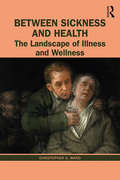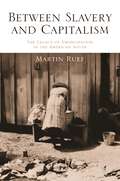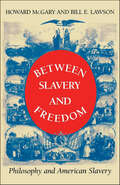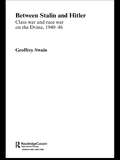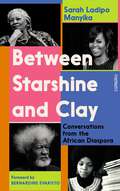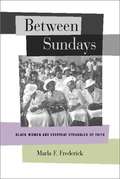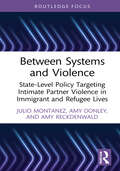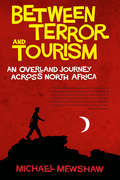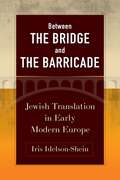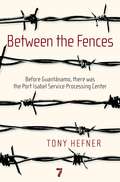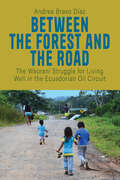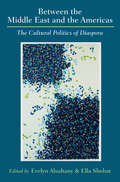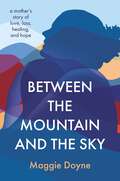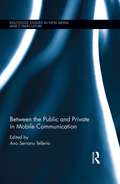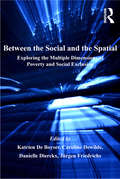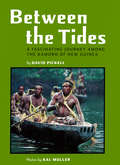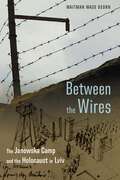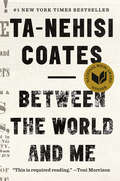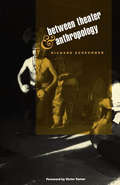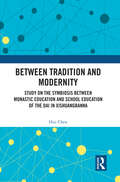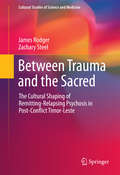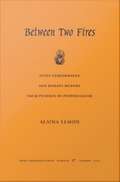- Table View
- List View
Between Sickness and Health: The Landscape of Illness and Wellness
by Christopher D. WardBetween Sickness and Health is about illness rather than disease, and recovery rather than cure. The book argues that illness is an experience, represented by the feeling that ‘I am not myself’. From the book’s phenomenological point of view, feelings of illness cannot be ‘unreal’ or ‘fake’, whatever their biological basis, nor need they be categorised as ‘physical’, ‘psychosomatic’ or ‘psychiatric’. The book challenges the disease-centred ethos of medicine and medical education. It demonstrates that a clearer conception of illness, as distinct from disease, is therapeutic. The feeling that ‘I am once again myself’ can return, in some degree, whatever state the body is in. Resilience becomes more available when it is seen as a set of personal skills that can be developed, rather than as an inborn trait. Possibilities of wellness are enhanced by recognising that medical and other therapies can either support or impede recovery, as can human relationships and the socio-political environment. The book’s many clinical examples are drawn from the author’s broad experience as a neurologist, rehabilitation physician and systemic family therapist. Between Sickness and Health will be useful for students, practitioners and academics, and also for anyone who has been or might one day be ill.
Between Slavery and Capitalism: The Legacy of Emancipation in the American South
by Martin RuefAn in-depth examination of the economic and social transition from slavery to capitalism during ReconstructionAt the center of the upheavals brought by emancipation in the American South was the economic and social transition from slavery to modern capitalism. In Between Slavery and Capitalism, Martin Ruef examines how this institutional change affected individuals, organizations, and communities in the late nineteenth century, as blacks and whites alike learned to navigate the shoals between two different economic worlds. Analyzing trajectories among average Southerners, this is perhaps the most extensive sociological treatment of the transition from slavery since W.E.B. Du Bois's Black Reconstruction in America.In the aftermath of the Civil War, uncertainty was a pervasive feature of life in the South, affecting the economic behavior and social status of former slaves, Freedmen's Bureau agents, planters, merchants, and politicians, among others. Emancipation brought fundamental questions: How should emancipated slaves be reimbursed in wage contracts? What occupations and class positions would be open to blacks and whites? What forms of agricultural tenure could persist? And what paths to economic growth would be viable? To understand the escalating uncertainty of the postbellum era, Ruef draws on a wide range of qualitative and quantitative data, including several thousand interviews with former slaves, letters, labor contracts, memoirs, survey responses, census records, and credit reports.Through a resolutely comparative approach, Between Slavery and Capitalism identifies profound changes between the economic institutions of the Old and New South and sheds new light on how the legacy of emancipation continues to affect political discourse and race and class relations today.
Between Slavery and Freedom: Philosophy and American Slavery (Blacks in the Diaspora)
by Howard McGary Bill E. LawsonUsing the writings of slaves and former slaves, as well as commentaries on slavery, Between Slavery and Freedom explores the American slave experience to gain a better understanding of six moral and political concepts—oppression, paternalism, resistance, political obligation, citizenship, and forgiveness. The authors use analytical philosophy as well as other disciplines to gain insight into the thinking of a group of people prevented from participating in the social/political discourse of their times.Between Slavery and Freedom rejects the notion that philosophers need not consider individual experience because philosophy is "impartial" and "universal." A philosopher should also take account of matters that are essentially perspectival, such as the slave experience. McGary and Lawson demonstrate the contribution of all human experience, including slave experiences, to the quest for human knowledge and understanding.
Between Stalin and Hitler: Class War and Race War on the Dvina, 1940-46 (BASEES/Routledge Series on Russian and East European Studies #Vol. 15)
by Geoffrey SwainCovering the horrors that took place in Latvia from the beginning of the Second World War until 1947, this book focuses on the heart of the 20th century: Stalinist industrialization, collectivization and political annihilation; Nazi expansionism and genocide; with local nationalism, local nationalist rivalries, and local anti-Semitism. The author traces the developments in one particular region of Latvia, Daugavpils. There, the dilemma of Hitler or Stalin, the ideological struggle of fascism or communism was more acute than anywhere else in Europe since the population was actively involved in establishing both.
Between Starshine and Clay: Conversations from the African Diaspora
by Sarah Ladipo Manyika<p>Conversations with the most distinguished black thinkers of our times, including Toni Morrison, Claudia Rankine, Wole Soyinka and Michelle Obama, on race, decolonisation, systemic inequalities, and the climate crisis.<p> <p>WITH A FOREWORD FROM BERNARDINE EVARISTO In a series of incisive and intimate encounters Sarah Ladipo Manyika introduces some of the most distinguished Black thinkers of our times, including Nobel Laureates Toni Morrison and Wole Soyinka, and civic leaders first lady Michelle Obama and Senator Cory Booker. She searches for truth with poet Claudia Rankine and historian Henry Louis Gates, Jr. She discusses race and gender with South African filmmaker Xoliswa Sithole and American actor and playwright Anna Deavere Smith. She interrogates the world around us with pioneering publisher Margaret Busby, parliamentarian Lord Michael Hastings and civil rights activist Pastor Evan Mawarire - who dared to take on President Robert Mugabe and has lived to tell the tale. We also meet the living embodiment of the many threads, ideas and histories in this book through the profile of her fabulous 102-year-old friend, Mrs Willard Harris. In journeys that book-end the collection, Sarah Ladipo Manyika reflects on her own experience of being seen as 'oyinbo' in Nigeria, African in England, Arab in France, coloured in Southern Africa and Black in America, while feeling the least Black and most human among her fellow travellers, explorers all, against the sharp white relief of the South Pole.<p>
Between Sundays: Black Women and Everyday Struggles of Faith
by Marla Faye FrederickTo be a black woman of faith in the American South is to understand and experience spirituality in a particular way. How this understanding expresses itself in everyday practices of faith is the subject of Between Sundays,an innovative work that takes readers beyond common misconceptions and narrow assumptions about black religion and into the actual complexities of African American women's spiritual lives. Gracefully combining narrative, interviews, and analysis, this book explores the personal, political, and spiritual commitments of a group of Baptist women whose experiences have been informed by the realities of life in a rural, southern community. In these lives, "spirituality" emerges as a space for creative agency, of vital importance to the ways in which these women interpret, inform, and reshape their social conditions--conditions often characterized by limited access to job opportunities, health care, and equitable schooling. In the words of these women, and in Marla F. Frederick's deft analysis, we see how spirituality--expressed as gratitude, empathy, or righteous discontent--operates as a transformative power in women's interactions with others, and in their own more intimate renegotiations of self.
Between Systems and Violence: State-Level Policy Targeting Intimate Partner Violence in Immigrant and Refugee Lives (Crime and Society Series)
by Julio Montanez Amy Donley Amy ReckdenwaldBetween Systems and Violence offers a compilation and analysis of state-level statutes targeting intimate partner violence (IPV) in immigrant and/or refugee (IMR) lives. The book analyzes such statutes’ legal language via various theoretical lenses, as well as provides a discussion of implications for research, prevention, intervention, and public policy. Some IMR victim-survivors of IPV, such as those who are undocumented, may be pinned "between systems and violence" as violent partners use the immigration system as a mechanism of power and control. While protections are available for these victim-survivors, the story told about the encompassing legal landscape remains incomplete and relegated to federal law. Graduate students, as well as scholars and practitioners, will acquire an in-depth understanding of this important nexus.
Between Terror and Tourism: An Overland Journey Across North Africa
by Michael MewshawFor his 65th birthday, acclaimed novelist Michael Mewshaw took a 4,000-mile overland trip across North Africa. Arriving in Egypt during food riots, he heads west into Libya, where billions in oil money have produced little except citizens eager to flee to Europe or join the jihad in Iraq. In Tunis, Mewshaw visits an abandoned Star Wars movie set where Al Qaeda has just kidnapped two tourists. Ignoring U.S. Embassy warnings he crosses into Algeria, traveling through mountain towns and seething metropolises where 200,000 people have died during more than a decade of sectarian violence. Searching for the tombs of seven monks murdered by Islamic fundamentalists, he reaches a village where six more people have been beheaded the day before. When he interviews a repentant terrorist responsible for 5,000 deaths, the man praises the Boy Scouts for training him.By contrast, the Moroccan city of Tangier seems almost tame. But then he meets the last literary protégé of Paul Bowles who accuses Bowles of plagiarism and murder. In the end, the reader, like the author, is immersed in a fascinating adventure that's sometimes tragic, often funny, occasionally terrifying and always a revelation of a strange place and its people.
Between the Bridge and the Barricade: Jewish Translation in Early Modern Europe (Jewish Culture and Contexts)
by Iris Idelson-SheinBetween the Bridge and the Barricade explores how translations of non-Jewish texts into Jewish languages impacted Jewish culture, literature, and history from the sixteenth century into modern times. Offering a comprehensive view of early modern Jewish translation, Iris Idelson-Shein charts major paths of textual migration from non-Jewish to Jewish literatures, analyzes translators’ motives, and identifies the translational norms distinctive to Jewish translation. Through an analysis of translations hosted in the Jewish Translation and Cultural Transfer (JEWTACT) database, Idelson-Shein reveals for the first time the liberal translational norms that allowed for early modern Jewish translators to make intensely creative and radical departures from the source texts—from “Judaizing” names, places, motifs, and language to mistranslating and omitting material both deliberately and accidently. Through this process of translation, Jewish translators created a new library of works that closely corresponded with the surrounding majority cultures yet was uniquely Jewish in character.As a site of intense negotiation between different cultures, communities, religions, readers, genres, and languages, these translations become an ideal entry point into the complex relationships between early modern Christians and Jews. At the same time, they also pose a significant challenge for modern-day scholars. But, for the careful reader, who can navigate the labyrinth of unacknowledged translations of non-Jewish sources into Jewish languages, there awaits a terrain of surprising intercultural encounters between Jews and Christians. Between the Bridge and the Barricade uncovers the hitherto hidden non-Jewish corpus that, Idelson-Shein contends, played a decisive role in shaping early modern Jewish culture.
Between the Conquests: The Early Chicano Historical Experience (4th edition)
by Michael R. OrnelasThis book is a unique collection of readings covering this early period--the span of history between the 16th century Spanish conquest and the United States conquest of Mexico in the Mexican American War--with a special focus on the distinctive Chicano experience.
Between the Fences: Before Guantanamo, there was the Port Isabel Service Processing Center
by Tony HefnerSomething at the Texas detention facility is terribly wrong, and Tony Hefner knows it. But the guards are repeatedly instructed not to speak of anything they witness. In the Rio Grande Valley, one of the most poverty-stricken areas in the United States, good jobs are scarce and the detention facility pays the best wages for a hundred miles. The guards follow orders and keep quiet.For six years, Tony Hefner was a security guard at the Port Isabel Service Processing Center, one of the largest immigration detention centers in America, and witnessed alarming corruption and violations of basic human rights. Officers preyed upon the very people whom they are sworn to protect. On behalf of the 1,100 men, women, and children residing there on an average day, and the 1,500 new undocumented immigrants who pass through its walls every month, this is the story of the systematic sexual, physical, financial, and drug-related abuses of detainees by guards.
Between the Forest and the Road: The Waorani Struggle for Living Well in the Ecuadorian Oil Circuit
by Andrea Bravo DíazDuring the past two decades Ecuadorians have engaged in a national debate around Buen Vivir (living well). This ethnography discusses one of the ways in which people experience well-being or aspire to live well in Ecuadorian Amazonia. Waponi Kewemonipa (living well) is a Waorani notion that embraces ideas of good conviviality, health and certain ecological relations. For the Waorani living along the oil roads, living well has taken many pathways. Notably, they have developed new spatial organizations as they move between several houses, and navigate between the economy of the market and the economy of the forest.
Between the Forest and the Road: Contemporary Transnational Television and Film
by Stephan Ehrig, Benjamin Schaper Elizabeth WardAudiences for contemporary German film and television are becoming increasingly transnational, and depictions of German cultural history are moving beyond the typical post-war focus on Germany’s problematic past. Entertaining German Culture explores this radical shift, building on recent research into transnational culture to argue that a new process of internal and external cultural reabsorption is taking place through areas of mutually assimilating cultural exchange such as streaming services, an increasingly international film market, and the import and export of Anglo-American media formats.
Between the Middle East and the Americas: The Cultural Politics of Diaspora
by Alsultany Evelyn Shohat EllaBetween the Middle East and the Americas: The Cultural Politics of Diaspora traces the production and circulation of discourses about "the Middle East" across various cultural sites, against the historical backdrop of cross-Atlantic Mahjar flows. The book highlights the fraught and ambivalent situation of Arabs/Muslims in the Americas, where they are at once celebrated and demonized, integrated and marginalized, simultaneously invisible and spectacularly visible. The essays cover such themes as Arab hip-hop's transnational imaginary; gender/sexuality and the Muslim digital diaspora; patriotic drama and the media's War on Terror; the global negotiation of the Prophet Mohammad cartoons controversy; the Latin American paradoxes of Turcophobia/Turcophilia; the ambiguities of the bellydancing fad; French and American commodification of Rumi spirituality; the reception of Iranian memoirs as cultural domestication; and the politics of translation of Turkish novels into English. Taken together, the essays analyze the hegemonic discourses that position "the Middle East" as a consumable exoticized object, while also developing complex understandings of self-representation in literature, cinema/TV, music, performance, visual culture, and digital spaces. Charting the shifting significations of differing and overlapping forms of Orientalism, the volume addresses Middle Eastern diasporic practices from a transnational perspective that brings postcolonial cultural studies methods to bear on Arab American studies, Middle Eastern studies, and Latin American studies. Between the Middle East and the Americas disentangles the conventional separation of regions, moving beyond the binarist notion of "here" and "there" to imaginatively reveal the thorough interconnectedness of cultural geographies.
Between the Mountain and the Sky: A Mother’s Story of Love, Loss, Healing, and Hope
by Maggie DoyneBetween the Mountain and the Sky shows us the goodness that is possible when a single person--regardless of age--takes action to help another and, in the process, changes the lives of hundreds. Maggie&’s story begins in suburban New Jersey, in a comfortable middle-class family that supports her decision to travel the world during a gap year before starting college. During her travels, the trajectory of her life alters when she has a surprise encounter with a Nepali girl breaking rocks in a quarry. Maggie decides to invest her life savings of five thousand dollars to buy a piece of land and open a children&’s home in Nepal.That home becomes Kopila Valley Children&’s Home, and eventually, the nonprofit Maggie launches, the BlinkNow Foundation, also starts the Kopila Valley School, which provides tuition-free education for more than four hundred students. Maggie and BlinkNow&’s work have been recognized around the world for their innovative, sustainable work.However, this book isn&’t a how-to for fledging philanthropists or nonprofit founders--it&’s a coming-of-age story about a young woman suspended between two worlds, as well as the love, loss, healing, and hope she experiences along the way. And Maggie&’s inspiring, intimate tale shows readers an important truth: the power to change the world exists within all of us.
Between the Public and Private in Mobile Communication (Routledge Studies in New Media and Cyberculture)
by Ana Serrano TelleríaMobile devices’ impact on daily life has raised relevant questions regarding public and private space and communication. Both the technological environment (operating systems, platforms, apps) and media ecosystems (interface design, participatory culture, social media) influence how users deal with the public and private, intimate and personal spheres. Leading researchers in communication, art, computer engineering, education, law, sociology, philosophy, and psychology here explore current methodologies for studying the dichotomy of the public and private in mobile communication, providing a foundation for further research.
Between the Social and the Spatial: Exploring the Multiple Dimensions of Poverty and Social Exclusion
by Katrien De Boyser Jürgen FriedrichsSince the beginning of the 1990s, the gradual widening of scientific and policy debates on poverty from a narrow focus on income poverty to a more inclusive concept of social exclusion, has made poverty research both more interesting and more complicated. This transition to a more multidimensional conceptualization of poverty forms the background and starting point of this book. Researchers studying the 'social' and 'spatial' dimensions of poverty have only started to challenge and explore the boundaries of each other's research perspectives and instruments. This book brings together these different bodies of literature on the intersection of spatial and social exclusion for the first time, by providing a state-of-the art review written by internationally-recognized experts who critically reflect on the theoretical status of their research on social exclusion, and on the implications this has for future research and policy-making agendas.
Between the Tides
by David PickellEighteen thousand Kamoro live along the southwestern coast of New Guinea. Their ancestors first roamed this land more than 50,000 years ago. By the early 1960s, just 50 years after the arrival of missionaries and colonial administrators, the unique culture of the Kamoro had been driven to the verge of extinction. Or so it was thought until photographer Kal Muller stumbled upon an initiation ceremony and found that traditional Kamoro life was still alive and thriving. This work provides an account of a culture that is rapidly disappearing and the wrenching process of change that the Kamoro have had to endure. It presents a portrait of how an isolated, nomadic past meets a worldly, urban future, and how history confronts superstition.
Between the Wires: The Janowska Camp and the Holocaust in Lviv
by Waitman Wade BeornBetween the Wires tells for the first time the history of the Janowska camp in Lviv, Ukraine. Located in a city with the third-largest ghetto in Nazi-occupied Europe, Janowska remains one of the least-known sites of the Holocaust, despite being one of the deadliest. Simultaneously a prison, a slave labor camp, a transit camp to the gas chambers, and an extermination site, this hybrid camp played a complex role in the Holocaust. Based on extensive archival research, Between the Wires explores the evolution and the connection to Lviv of this rare urban camp. Waitman Wade Beorn reveals the exceptional brutality of the SS staff alongside an almost unimaginable will to survive among prisoners facing horrendous suffering, whose resistance included an armed uprising. This integrated chronicle of perpetrators, victims, and bystanders follows the history of the camp into the postwar era, including attempts to bring its criminals to justice.
Between the World and Me
by Ta-Nehisi Coates“This is your country, this is your world, this is your body, and you must find some way to live within the all of it.”<P><P> In a profound work that pivots from the biggest questions about American history and ideals to the most intimate concerns of a father for his son, Ta-Nehisi Coates offers a powerful new framework for understanding our nation’s history and current crisis. Americans have built an empire on the idea of “race,” a falsehood that damages us all but falls most heavily on the bodies of black women and men—bodies exploited through slavery and segregation, and, today, threatened, locked up, and murdered out of all proportion. What is it like to inhabit a black body and find a way to live within it? And how can we all honestly reckon with this fraught history and free ourselves from its burden?<P> Between the World and Me is Ta-Nehisi Coates’s attempt to answer these questions in a letter to his adolescent son. Coates shares with his son—and readers—the story of his awakening to the truth about his place in the world through a series of revelatory experiences, from Howard University to Civil War battlefields, from the South Side of Chicago to Paris, from his childhood home to the living rooms of mothers whose children’s lives were taken as American plunder. Beautifully woven from personal narrative, reimagined history, and fresh, emotionally charged reportage, Between the World and Me clearly illuminates the past, bracingly confronts our present, and offers a transcendent vision for a way forward.<P> <b>Winner of the National Book Award</b> <p> <b>Winner of the 2016 Alex Award (10 best adult books that appeal to teen audiences)</b> <P><b> Nominee for the 2018 Young Reader's Choice Award </b> <i>(Pacific Northwest Library Association)</i>
Between Theater and Anthropology
by Victor Turner Richard SchechnerIn performances by Euro-Americans, Afro-Americans, Native Americans, and Asians, Richard Schechner has examined carefully the details of performative behavior and has developed models of the performance process useful not only to persons in the arts but to anthropologists, play theorists, and others fascinated (but perhaps terrified) by the multichannel realities of the postmodern world.Schechner argues that in failing to see the structure of the whole theatrical process, anthropologists in particular have neglected close analogies between performance behavior and ritual. The way performances are created--in training, workshops, and rehearsals--is the key paradigm for social process.
Between Tradition and Modernity: Study on the Symbiosis Between Monastic Education and School Education of the Dai in Xishuangbanna
by Hui ChenHow to deal with the relationship between tradition and modernity has become a global concern under the impact of pluralism. This book explores the relationship between traditional Dai culture and modern school education through a field study in the Dai region of Xishuangbanna, Yunnan, China. The study analyses the reasons for conflicts between monastic education and modern school education in the Dai region of Xishuangbanna. It also discusses the logic behind the formation of the Dai people’s belief in Southern Theravada Buddhism and its importance in Dai culture. Through the analysis of the changes in monastic education before and after the intervention of the modern school system, the study finds symbiosis in the differences and conflicts between these two forms of education. The author proposes a symbiosis theory of multiple educational forms in ethnic areas and offers targeted solutions to specific problems between the Dai monastic education and modern school education in Xishuangbanna. This book will be a great read to students and scholars of Chinese studies, ethnic studies, education, and those who are interested in multi- ethnicity issues in general.
Between Trauma and the Sacred: The Cultural Shaping of Remitting-Relapsing Psychosis in Post-Conflict Timor-Leste (Cultural Studies of Science and Medicine)
by James Rodger Zachary SteelThe relatively frequent occurrence of rapid onset and very brief, but often florid, psychotic states, with periodic recurrence, alongside relatively low rates of PTSD and chronic psychosis, were unexpected findings from the 2004 East Timor Mental Health Study, conducted in the context of the country's recently won independence and in the wake of the atrocities endured in the protracted fight for sovereignty. Further unanticipated was the frequent association of recurrence with the time of the new moon (fulan lotuk) and other times or places of sacred (lulik) or associated cultural significance. The perceived violation of culturally sacrosanct lulik obligations often also appeared to foreshadow the initial onset of such patterns of distress. Significant episodes of trauma and loss appeared a hidden feature of affected individuals histories, which we argue have become symbolically entwined with local cultural understandings of ritual obligation, sacredness, and taboo. -ansi-language:EN-GB;mso-fareast-language: EN-US;mso-bidi-language:AR-SA;mso-bidi-font-style:italic"> This volume develops a dynamic but contextualized multi-level formulation of psychosis and psychotic-symptoms, able to incorporate a range of factors from the biological, through the sociocultural, to the political. The work is truly interdisciplinary drawing on both the quantitative and qualitative findings of our own study but further supported through local ethnography and broader anthropological enquiry into the outcomes of psychosis in non-Western settings; psychoanalysis and psychoanalytic anthropology; evidence and theory exploring links between trauma, dissociation and psychosis; and novel culturally-adaptable psychosocial focused interventions for psychosis. We situate both evidence and theorising in wider epistemological and political context, including in relation to the movement for Global Mental Health. Culturally patterned presentations of brief remitting-relapsing psychosis are ultimately conceived as the trade-off between competing fragmentary and synthetic forces: the former in part secondary to the lasting and deleterious effects of overwhelming loss, trauma and adversity; the latter emboldened by cultural meaning and social response in the context of broad ecological pressures demanding survival and resilience.
Between Two Absolutes: Public Opinion And The Politics Of Abortion
by Elizabeth Adell CookThis book examines the shape and direction of public attitudes toward abortion. It looks at the social and demographic basis of public opinion on the abortion issue. The book is also concerned with the consequences of abortion politics.
Between Two Fires: Gypsy Performance and Romani Memory from Pushkin to Postsocialism
by Alaina LemonSince tsarist times, Roma in Russia have been portrayed as both rebellious outlaws and free-spirited songbirds--in each case, as if isolated from society. In Soviet times, Russians continued to harbor these two, only seemingly opposed, views of "Gypsies," exalting their songs on stage but scorning them on the streets as liars and cheats. Alaina Lemon's Between Two Fires examines how Roma themselves have negotiated these dual images in everyday interactions and in stage performances. Lemon's ethnographic study is based on extensive fieldwork in 1990s Russia and focuses on Moscow Romani Theater actors as well as Romani traders and metalworkers. Drawing from interviews with Roma and Russians, observations of performances, and conversations, as well as archives, literary texts, and media, Lemon analyzes the role of theatricality and theatrical tropes in Romani life and the everyday linguistics of social relations and of memory. Historically, the way Romani stage performance has been culturally framed and positioned in Russia has served to typecast Gypsies as "natural" performers, she explains. Thus, while theatrical and musical performance may at times empower Roma, more often it has reinforced and rationalized racial and social stereotypes, excluding them from many Soviet and Russian economic and political arenas. Performance, therefore, defines what it means to be Romani in Russia differently than it does elsewhere, Lemon shows. Considering formal details of language as well as broader cultural and social structures, she also discusses how racial categories relate to post-Soviet economic changes, how gender categories and Euro-Soviet notions of civility are connected, and how ontological distinctions between "stage art" and "real life" contribute to the making of social types. This complex study thus serves as a corrective to romantic views of Roma as detached from political forces.
